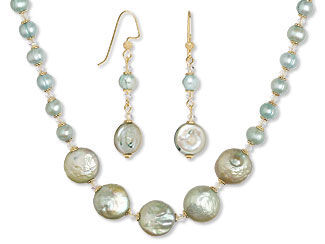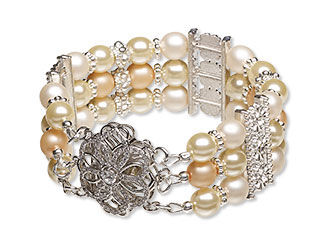Pearl Jewelry Guide How to Choose, Buy and Style Pearls like a Pro
The pearl, with its celestial glow and mystery, is the only gemstone formed within a living creature. Across history and cultures, pearls have symbolized wealth, sophistication and natural beauty. Ancient Chinese legend tells how the moon holds the power to create pearls, while Arabic lore says pearls formed from dewdrops filled with moonlight that fell into the ocean and were swallowed by oysters.
In this guide, learn everything you need to know about pearls: the difference between natural and cultured varieties, popular pearl types, pearl grading and enhancement, factors affecting pearl pricing and how to care for and accessorize with these timeless gems.
To begin, watch this video to discover the timeless beauty of cultured freshwater pearls, known as June’s birthstone. Delve into their fascinating world, including information on grading, proper care and cleaning techniques and even learn how to create a stunning pearl of cultured freshwater pearl drop earrings.

What is the Difference Between Natural and Cultured Freshwater Pearls?
A natural pearl forms when a foreign object, such as a grain of sand, becomes trapped inside an oyster. As a defense, the oyster secretes nacre, layer after layer, around the irritant. Natural pearls are extremely rare—only one in 10,000 oysters might produce a single pearl.
Due to this rarity, most pearls today are cultured. The culturing process, pioneered by Kokichi Mikimoto in 1916, involves carefully implanting a polished shell bead into an oyster to stimulate pearl production. Though human-initiated, the process still relies on nature to create the pearl’s beauty.
Cultured pearls can come from both saltwater and freshwater mollusks.
- Freshwater pearls are grown in lakes and rivers, mainly in China.
- Saltwater pearls, including Akoya, South Sea and Tahitian varieties, are cultivated in ocean waters.
Both cultured and natural pearls share the same chemical properties and organic formation process.
What are Popular Types of Pearls?
Freshwater Pearls:
Cultivated mainly in China, freshwater pearls come in a wide range of shapes, sizes and natural colors. They are often more affordable and durable, making them ideal for everyday wear and creative jewelry designs.
Akoya Pearls:
Originally cultured in Japan, Akoya pearls are known for their classic white color, high luster, and perfect round shape.
Tahitian Black Pearls:
Cultivated from the black-lipped oyster in French Polynesia, these exotic pearls range in color from silver to graphite with overtones of green, blue, or purple.
South Sea Pearls:
The rarest and often the largest, South Sea pearls come from the warm waters between Australia and China. They feature a luxurious satiny luster and range from silvery white to deep gold.
Keshi Pearls:
Formed accidentally when oysters reject their implanted nuclei, keshi pearls are 100% nacre, highly lustrous and available in a variety of irregular shapes and colors.
Crystal and Glass Pearls:
For affordable alternatives, many jewelry designers turn to Crystal Passions® pearl beads and Celestial Crystal® glass pearls. These are made with a crystal core and a pearlescent coating, offering a beautiful luster at a lower cost, perfect for high-fashion designs.
How are Pearls Graded?
Pearl grading standards vary across suppliers. Fire Mountain Gems and Beads uses the Chinese grading system:
 |
A Grade: | Extremely well shaped, white, high luster, very minor surface blemishes. |
 |
B Grade: | Well shaped, white to light cream, high luster, minor surface blemishes. |
 |
C Grade: | Irregular shape, off-white, medium luster (may be non-uniform), surface is irregular. |
 |
D Grade: | Same as C grade, but one or more of the characteristics are excessively bad (such as areas of no luster or wrinkled surfaces). |
| F Grade: | For promotional purposes only. Not suitable for jewelry. Most of this grade is ground up into pearl powder (used in cosmetics). |
Some pearls may fall between standard grades and receive a mixed grade, such as A-B. For example, a pearl with A-grade luster but a C-grade surface might be assigned a compromise B grade; however, Fire Mountain Gems and Beads strives to avoid offering pearls with significant grade discrepancies.
What are Pearl Enhancements?
Fire Mountain Gems and Beads, a charter member of the AGTA (American Gem Trade Association), fully discloses all gemstone enhancements (except for normal cutting and polishing), adhering to AGTA's higher standards beyond those of the FTC.
| Symbols for Specific Forms of Enhancements: | |
| Natural (N) | Stones which are not currently known to be enhanced. |
| Bleached | The use of heat, light and/or other agents to lighten or remove a gemstone's color. |
| Dyed | The introduction of color matter onto a pearl to give it new color, intensify present color or improve color uniformity. |
| Irradiated (R) | The use of neutrons, gamma rays or beta particles (high energy electrons) to alter a pearl's color. |
| Symbols for Specific Forms of Enhancements: | |
| Natural (N) | Stones which are not currently known to be enhanced. |
| Bleached | The use of heat, light and/or other agents to lighten or remove a gemstone's color. |
| Dyed | The introduction of color matter onto a pearl to give it new color, intensify present color or improve color uniformity. |
| Irradiated (R) | The use of neutrons, gamma rays or beta particles (high energy electrons) to alter a pearl's color. |
| Code Enhancement Method | ||
| Pearl (Bleached) | B | Bleached to improve color and appearance |
| Pearl (Dyed) | D | Dyed to give rose, blue or golden overtones or a chemical treatment combined with heat (also called electro-coated) to produce grey to black color |
How to Care for Pearls
Because pearls are organic and delicate, proper care is essential:
- Avoid contact with perfume, hairspray, lotions with citrus oils and harsh chemicals.
- Remove pearls before exercising to prevent damage from perspiration.
- Wipe pearls with a soft cloth after each wear.
- Store pearls in a soft pouch, separate from other jewelry.
- Clean with mild soap and water when needed, ensuring cords are fully dry before wearing again.
- Never use ultrasonic cleaners or steamers.
- Re-string pearls annually if worn frequently.
Pearls contain natural moisture and can crack if exposed to overly dry environments. Interestingly, the natural oils from human skin help maintain a pearl’s luster—so wear your pearls often!
What Affects the Price of Pearls?
Several factors contribute to the pricing and value of pearls.
Environment and Supply:
Oysters are sensitive to water pollution. Clean, healthy environments are crucial for successful pearl cultivation. Even minor contamination can devastate farms, affecting supply and pricing.
Weather:
Extreme weather events such as floods or temperature fluctuations can harm oyster populations, disrupting years of cultivation.
Water Management:
China’s efforts to preserve clean water have pushed pearl farms into rural areas, increasing operational costs and, in turn, raising pearl prices.
World Economy:
Global financial shifts impact the pearl market, much like fluctuations in oil prices. Changes in currency value, economic conditions, and demand from major markets like the U.S., Japan, and China all affect pearl pricing.
Size and Fashion Trends:
Larger pearls are increasingly in demand. Producing larger pearls takes longer and results in fewer high-quality specimens, pushing up prices. Meanwhile, skilled labor for drilling pearls has become more expensive, especially for smaller sizes.
Despite rising costs, pearls remain highly desirable for their timeless beauty and classic appeal.
How to Accessorize with Pearls
Pearls are both timeless and trendy, adaptable to any style or occasion. A single-strand pearl necklace is a must-have classic, but pearls are also being worn in new, creative ways—layered, mixed with gemstones and incorporated into contemporary jewelry designs.
Pearl necklaces are commonly defined by where they hang when worn around the neck, instead of by their physical measurement. Here’s a guide for pearl necklace lengths and how to accessorize with pearl necklaces.

The Pearl Collar - 14 to 17 inches
Three or more strands that fit snugly on the middle of the neck. Accessorize with boat neck, V-neck, or off-the-shoulder fashions.

The Pearl Choker - 16 to 18 inches
A versatile pearl choker is appropriate for accessorizing casual to formal eveningwear, and complements almost any neckline.

The Princess Necklace - 17 to 19 inches
The most common pearl necklace length, the princess necklace is well suited for crew and high necklines. It also complements low, plunging necklines.

The Matinee Necklace - 20 to 25 inches
A pearl matinee necklace is an ideal choice for casual or business attire. Looks best with high necklines and adds sophistication to a professional look.

The Opera Necklace - 26 to 36 inches
Worn as a single strand with high necklines or doubled to create a fashionable two-strand choker. Knot at the neckline or above the bust to create a stylish vintage look and accessorize with casual attire for a cutting-edge fashion statement.

The Pearl Rope - 37 inches or longer
A favorite of Coco Chanel, this luxurious length can be made with several clasps, enabling it to be broken down into different necklace and bracelet combinations, or doubled and even tripled to create a stunning multi-strand choker. Pearl ropes can also be knotted and slung over the shoulder to accentuate the beauty of a backless dress.
Armed with these "pearls of wisdom," you have the power to design and create pearl jewelry that is both timeless and sought-after for all occasions, and appeal to many tastes.
Shop for Your Materials Here:
Have a question regarding this resource? Email Customer Service.
Copyright Permissions
All works of authorship (articles, videos, tutorials and other creative works) are from the Fire Mountain Gems and Beads® Collection, and permission to copy is granted for non-commercial educational purposes only. All other reproduction requires written permission. For more information, please email copyrightpermission@firemtn.com.





















